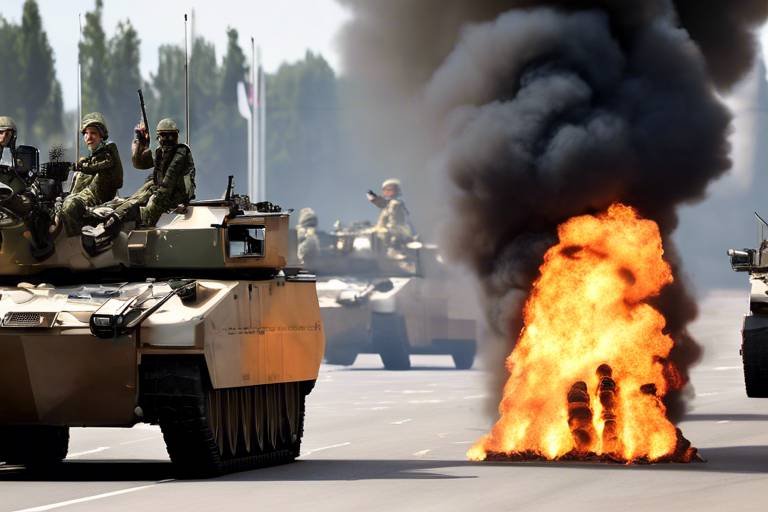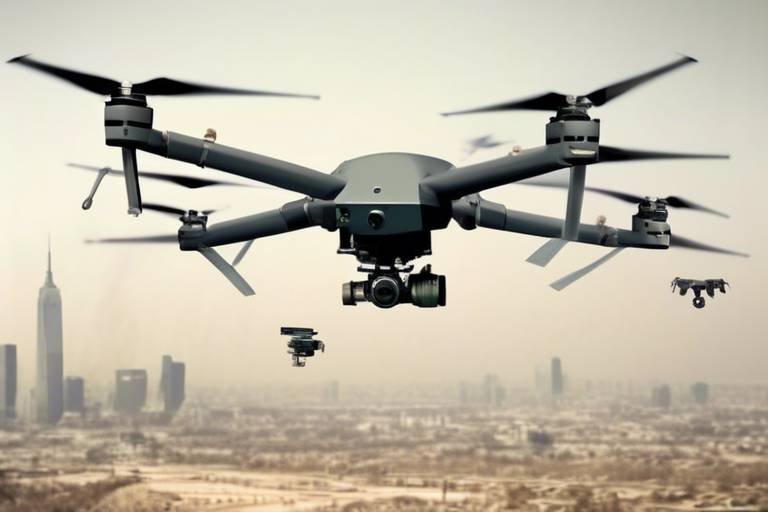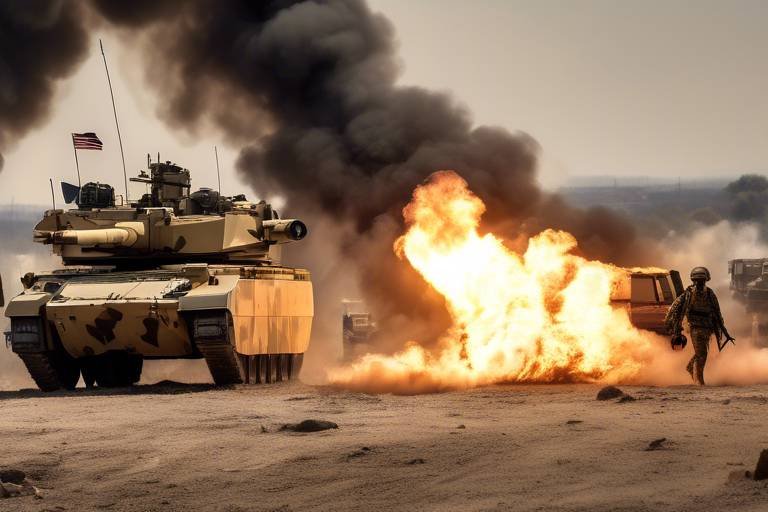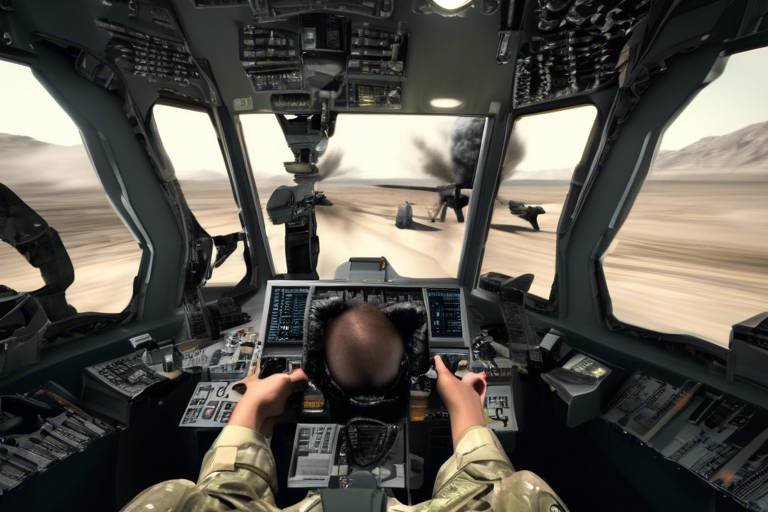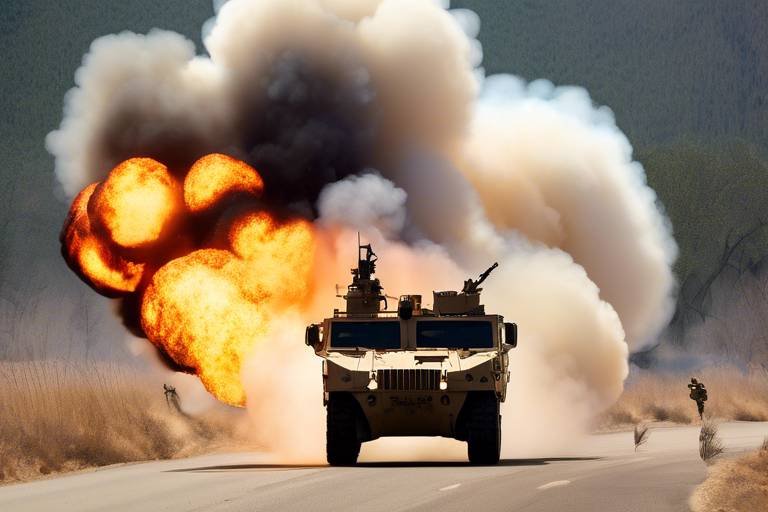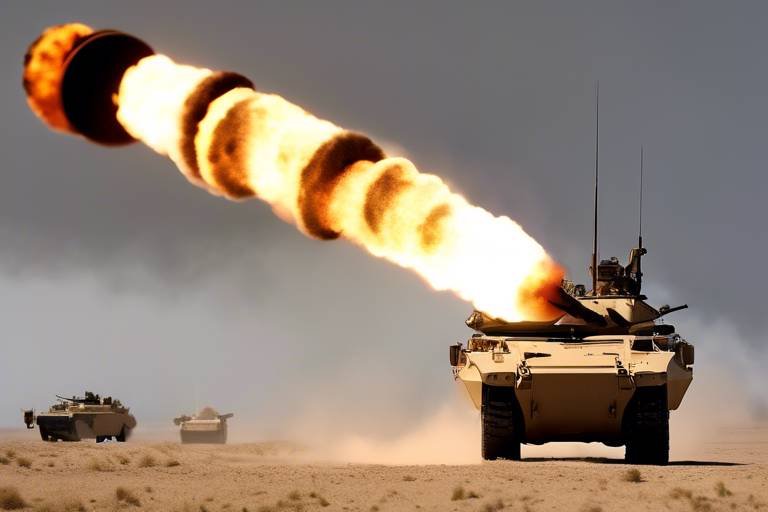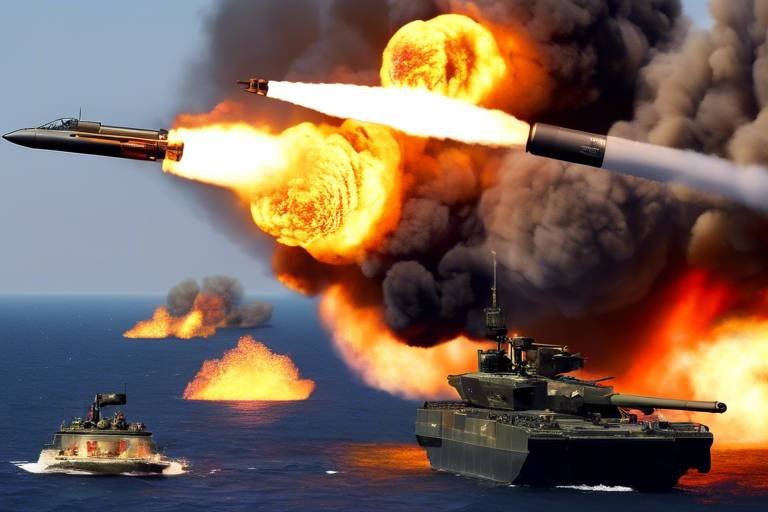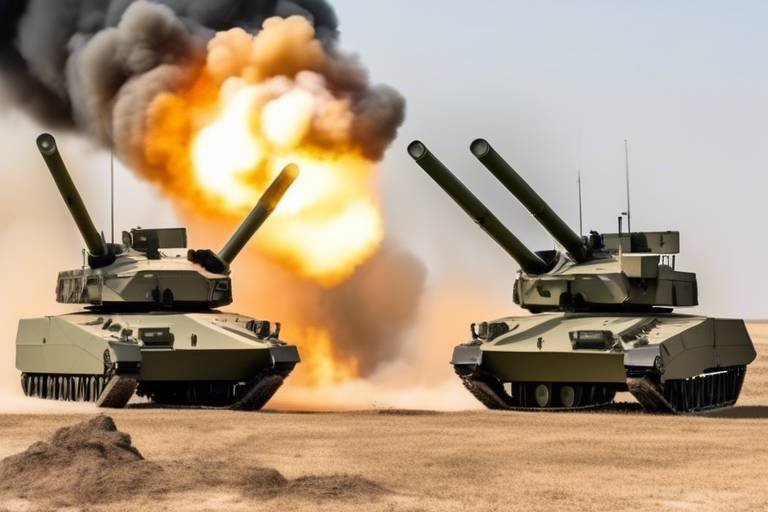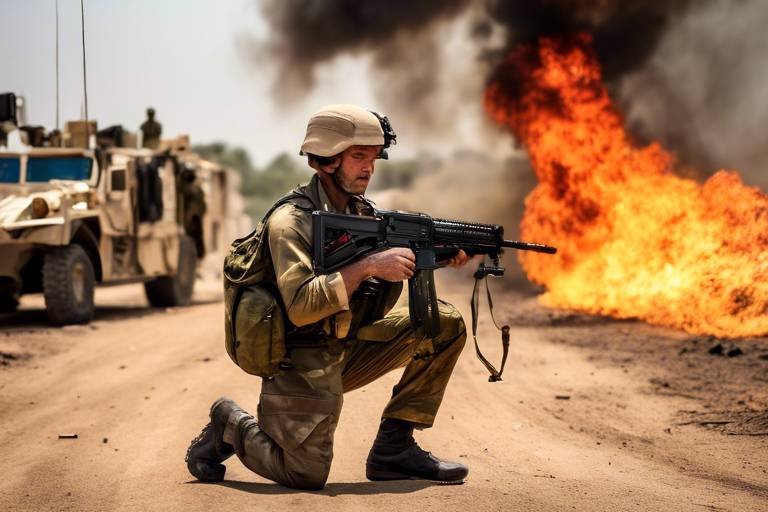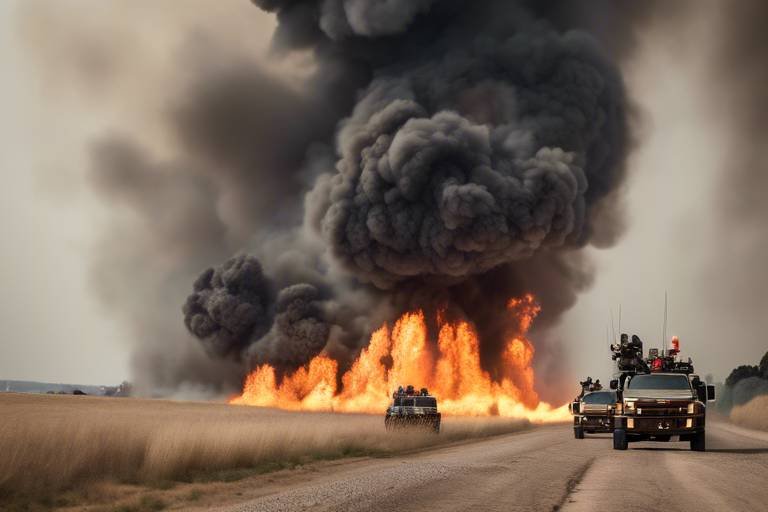The Role of Firepower in Global Stability
In today's world, the concept of firepower is more than just a military term; it represents a crucial element in shaping international relations and maintaining peace. As nations navigate the complexities of global politics, their military strength often serves as a benchmark for stability and security. But how does firepower influence the intricate web of international diplomacy? This article delves into the multifaceted role of military strength in fostering global stability, exploring both its advantages and the potential risks associated with its use.
To truly grasp the significance of firepower, we must first understand its definition and components. Firepower refers to the capacity of a military to deliver force, whether through conventional arms, advanced technology, or strategic capabilities. This includes everything from infantry and armored vehicles to naval fleets and aerial bombardment systems. The significance of firepower in military strategy cannot be overstated; it shapes national security policies, influences defense spending, and ultimately dictates how nations interact on the global stage.
Looking back at history, we can see that firepower has played a pivotal role in major conflicts and territorial disputes. For instance, the evolution of military tactics throughout the ages has often been dictated by advancements in firepower. From the introduction of gunpowder to the development of modern missile systems, each leap in technology has transformed warfare and its implications for international stability. Understanding these historical contexts allows us to appreciate the ongoing impact of military strength on global relations.
The World Wars serve as critical case studies in the evolution of firepower and its effect on international relations. The sheer scale of destruction brought about by World War I and World War II showcased how advancements in military technology could alter the course of history. Countries that once had the upper hand found themselves at the mercy of new tactics and weaponry. For example, the introduction of tanks and aircraft changed ground warfare, while naval power shifted with the advent of aircraft carriers. These changes not only redefined military strategies but also led to significant shifts in global power dynamics.
One of the most profound developments in military history has been the introduction of nuclear weapons. The atomic bomb fundamentally changed the landscape of global conflict by establishing a new paradigm of deterrence. Nations now had to navigate a complex web of alliances and threats, where the mere existence of nuclear capabilities could deter aggression. This delicate balance of power continues to influence international relations today, as countries grapple with the implications of nuclear proliferation and the ongoing quest for stability.
While nuclear weapons dominate discussions about firepower, conventional military forces remain critical in contemporary conflicts. Ground troops, naval forces, and air power are essential in peacekeeping efforts and geopolitical tensions worldwide. The effectiveness of conventional forces in addressing regional conflicts and humanitarian crises cannot be underestimated. As nations engage in military operations, the balance between using firepower for defense and maintaining peace becomes increasingly intricate.
Interestingly, firepower is not solely associated with warfare. It plays a crucial role in peacekeeping missions, where military strength can deter aggression and maintain order in conflict-affected regions. In many cases, a visible military presence can prevent the escalation of violence, allowing for diplomatic solutions to take root. The ability to project power in a non-aggressive manner can be a game-changer in stabilizing volatile areas and fostering long-term peace.
The balance of power theory posits that military strength among nations can prevent any single state from dominating others, fostering stability through deterrence and alliances. This concept is particularly relevant in today's multipolar world, where emerging powers challenge established norms. By maintaining a balance of firepower, countries can work collaboratively to address global challenges, from climate change to terrorism.
Organizations like NATO exemplify how collective firepower can enhance security and deter threats. By pooling military resources, member states can create a formidable deterrent against potential aggressors. This military cooperation not only promotes stability among allies but also shapes the global geopolitical landscape, as nations recognize the importance of unity in the face of shared threats.
Regional conflicts often illustrate the complexities of firepower dynamics. Local military capabilities can significantly influence stability, peace negotiations, and international interventions. For instance, in areas where firepower is unevenly distributed, tensions can escalate, leading to prolonged conflicts. Understanding these dynamics is essential for international actors aiming to mediate disputes and foster lasting peace.
- What is firepower? Firepower refers to the military's capacity to deliver force through various means, including conventional arms and advanced technology.
- How has firepower influenced historical conflicts? Advancements in firepower have transformed military tactics and strategies, significantly impacting the outcomes of major conflicts.
- What role do nuclear weapons play in global stability? Nuclear weapons establish deterrence strategies that influence international relations and contribute to maintaining a balance of power.
- How does firepower contribute to peacekeeping efforts? A visible military presence can deter aggression and help maintain order in conflict-affected regions, facilitating diplomatic solutions.
The Concept of Firepower
When we talk about firepower, we're diving into a concept that goes far beyond just the weapons themselves. It encompasses a wide range of elements that contribute to a nation's military might and its ability to project power on the global stage. Firepower is essentially the capacity to deliver force, which includes not only the actual weaponry but also the technology, logistics, and strategic planning that support military operations.
At its core, firepower can be broken down into several key components:
- Weaponry: This includes everything from small arms to advanced missile systems and nuclear arsenals.
- Technology: Innovations such as drones, cyber warfare capabilities, and satellite systems enhance a nation’s ability to utilize its firepower effectively.
- Logistics: The capability to supply, transport, and maintain military forces is crucial for ensuring that firepower can be deployed when and where it’s needed.
- Training: Highly trained personnel are essential for maximizing the effectiveness of any military hardware.
Understanding firepower is not just about the tools of war; it’s about how these tools are integrated into a comprehensive military strategy. Nations constantly assess their firepower in relation to potential threats, which shapes their national security policies. For example, a country may invest heavily in missile defense systems if it perceives a rising threat from an adversary. This investment alters the balance of power and can either deter conflict or escalate tensions, depending on how other nations respond.
Moreover, firepower plays a significant role in international relations. It acts as a double-edged sword; while it can deter aggression and maintain peace, it can also provoke arms races and conflicts. Countries with significant firepower often wield considerable influence in diplomatic negotiations, making military strength a critical component of their foreign policy strategies.
In summary, firepower is a multifaceted concept that encompasses weaponry, technology, logistics, and training. It is a vital element in shaping a nation’s security policies and international relations. Understanding its implications is crucial for grasping the dynamics of global stability and the intricate dance of power among nations.
Historical Perspectives on Firepower
The history of firepower is as rich and complex as the very fabric of human conflict itself. From the early days of rudimentary weaponry to the sophisticated arsenals of modern nations, the evolution of firepower has been a key factor in shaping international relations. Understanding this trajectory is crucial to grasping how military strength influences global stability. The advent of gunpowder in the 9th century marked a significant turning point, introducing a new dimension to warfare. As armies began to harness the destructive potential of cannons and firearms, the nature of battles transformed dramatically.
Throughout history, various conflicts have showcased the profound impact of firepower on military strategy and outcomes. For instance, during the Napoleonic Wars, the effective use of artillery reshaped battlefield tactics, leading to more decisive engagements. These developments not only altered the course of wars but also influenced the political landscape, as nations recognized the importance of maintaining a robust military capability. As we delve deeper into the 20th century, the two World Wars serve as critical case studies that exemplify how advancements in firepower can reshape global power dynamics.
In World War I, the introduction of machine guns and heavy artillery changed the nature of trench warfare, resulting in unprecedented casualties and a stalemate that lasted for years. The sheer firepower available to both sides forced military leaders to rethink strategies, leading to innovations such as tanks and aircraft. This conflict demonstrated that firepower could not only determine the outcome of battles but also influence the very course of history.
World War II further escalated the arms race, with the introduction of more advanced technologies, including bombers and, most notably, nuclear weapons. The atomic bombings of Hiroshima and Nagasaki in 1945 marked a watershed moment in military history, illustrating the terrifying potential of firepower. The concept of mutually assured destruction emerged, fundamentally altering the nature of international relations and establishing a delicate balance that persists to this day.
The introduction of nuclear weapons has created a paradox in global stability. On one hand, the destructive capability of these weapons serves as a powerful deterrent against large-scale conflicts; on the other, it raises the stakes for international diplomacy. Nations are often compelled to engage in arms control negotiations to prevent escalation, as seen in treaties like the Non-Proliferation Treaty (NPT). The fear of nuclear confrontation has led to a unique form of stability, albeit one that is fraught with tension and uncertainty.
While nuclear weapons dominate discussions of firepower, conventional military forces remain critical in contemporary conflicts. The deployment of air and ground troops in various regions highlights how traditional military might continues to impact peacekeeping efforts and geopolitical tensions. Recent conflicts in the Middle East and Eastern Europe have showcased the complexities of modern warfare, where firepower is not just about sheer numbers but also about technological superiority and strategic alliances.
In summary, the historical perspectives on firepower reveal a continuous evolution that has shaped not only military tactics but also the broader landscape of international relations. The interplay between advancements in firepower and the political ramifications of those advancements continues to be a defining characteristic of global stability.
- What is firepower? Firepower refers to the capacity of a military force to deliver effective fire against an enemy, encompassing both the weapons used and the strategies employed.
- How has firepower influenced international relations? Firepower shapes international relations by establishing deterrence, influencing alliances, and determining the outcomes of conflicts.
- What role did nuclear weapons play in global stability? Nuclear weapons have created a deterrent effect that prevents large-scale wars, while also introducing new complexities into international diplomacy.
- How do conventional forces impact modern conflicts? Conventional forces are essential for peacekeeping and military operations, influencing regional stability and geopolitical dynamics.
World Wars and Firepower
The World Wars stand as monumental events in history, profoundly shaping our understanding of firepower and its impact on warfare and international relations. During these cataclysmic conflicts, nations were compelled to innovate and expand their military capabilities to unprecedented levels. The sheer scale of destruction wrought by advanced weaponry not only altered battlefields but also redefined the very essence of global power dynamics.
In World War I, the introduction of machine guns, tanks, and chemical warfare transformed traditional combat strategies. Soldiers faced a new reality where the speed and lethality of firepower dictated the pace of war. The trench warfare that characterized much of this conflict illustrated how firepower could create stalemates, leading to horrific casualties without significant territorial gains. The technological advancements made during this time laid the groundwork for future military strategies, showcasing the critical role that firepower plays in shaping the outcomes of conflicts.
Fast forward to World War II, and we witness an even more dramatic evolution in firepower. The war introduced aerial bombardments, aircraft carriers, and, most notably, nuclear weapons. The bombings of Hiroshima and Nagasaki not only resulted in immense loss of life but also established a chilling precedent for the use of nuclear firepower in international relations. This period highlighted the dual-edged nature of firepower: while it can serve as a deterrent, it can also lead to catastrophic consequences if mismanaged or unleashed.
To illustrate the evolution of firepower during the World Wars, consider the following table:
| Conflict | Key Innovations in Firepower | Impact on Warfare |
|---|---|---|
| World War I | Machine Guns, Tanks, Chemical Weapons | Stalemate, Trench Warfare |
| World War II | Aerial Bombardments, Aircraft Carriers, Nuclear Weapons | Fast-Paced Warfare, Total War Strategy |
As we analyze these conflicts, it's essential to recognize how firepower not only influences the strategies employed by military leaders but also impacts the political landscape. The aftermath of the World Wars led to a reconfiguration of alliances and the establishment of international organizations aimed at preventing future conflicts. The lessons learned from the devastating effects of firepower during these wars continue to resonate in today’s geopolitical climate.
In conclusion, the World Wars serve as critical case studies that illuminate the profound influence of firepower on warfare and international relations. The advancements made during these conflicts set the stage for modern military strategies and continue to shape our understanding of global stability. As we navigate the complexities of contemporary conflicts, acknowledging the historical context of firepower remains crucial for fostering a more peaceful world.
- What role did firepower play in the World Wars? Firepower was central to the strategies employed during the World Wars, leading to significant advancements in military technology and altering the nature of warfare.
- How did nuclear weapons change global stability? The introduction of nuclear weapons established a deterrence strategy that continues to influence international relations and conflict resolution today.
- What lessons can we learn from the World Wars regarding firepower? The World Wars illustrate the importance of managing firepower responsibly to prevent catastrophic consequences and promote global peace.
Nuclear Weapons and Deterrence
Nuclear weapons have fundamentally transformed the landscape of global conflict since their inception. The mere existence of these weapons has created a precarious balance of power among nations, where the threat of mutual destruction acts as a powerful deterrent against large-scale wars. Imagine a high-stakes poker game where each player holds a gun under the table; the fear of what could happen if someone loses their cool keeps everyone in check. This is the essence of nuclear deterrence.
The concept of deterrence relies heavily on the idea that if one nation possesses nuclear weapons, it can dissuade potential aggressors from attacking, knowing that the consequences would be catastrophic. This relationship can be summarized in a simple equation: Power Fear. Countries with nuclear capabilities, such as the United States, Russia, and China, have been able to wield considerable influence on the global stage, often dictating terms in international negotiations and conflicts.
However, the presence of nuclear weapons is not without its complexities. While they serve as a deterrent, they also pose significant risks. The potential for accidents, miscalculations, or unauthorized launches represents a constant threat to global stability. For instance, during the Cold War, the world teetered on the brink of nuclear war due to misunderstandings and the high tension between superpowers. This delicate dance of diplomacy and military readiness illustrates the paradox of nuclear deterrence: while it can prevent wars, it can also lead to dangerous situations where a single misstep could have dire consequences.
Moreover, the proliferation of nuclear technology has added another layer of complexity to international relations. As more nations seek to develop their own nuclear arsenals, the risk of regional conflicts escalating into nuclear confrontations increases. Countries like North Korea and Iran have sparked international tensions, leading to debates about the effectiveness of existing treaties and the need for new frameworks to manage nuclear proliferation.
| Country | Nuclear Arsenal Size | Year of First Test |
|---|---|---|
| United States | 5,800 | 1945 |
| Russia | 6,375 | 1949 |
| China | 320 | 1964 |
| France | 290 | 1960 |
| United Kingdom | 225 | 1952 |
| India | 160 | 1974 |
| Pakistan | 170 | 1998 |
| North Korea | 40-50 | 2006 |
In summary, while nuclear weapons serve as a formidable deterrent against aggression, their existence also brings forth a myriad of challenges that can destabilize global peace. The ongoing dialogue surrounding disarmament, non-proliferation, and international cooperation is crucial in navigating this intricate web of power dynamics. As we move forward, the question remains: can humanity find a way to coexist with such destructive capabilities, or are we destined to continue this perilous game of nuclear brinkmanship?
- What is nuclear deterrence? Nuclear deterrence is the strategy of preventing aggression by the threat of retaliatory nuclear attack.
- How many countries possess nuclear weapons? As of now, nine countries are known to possess nuclear weapons.
- What are the risks associated with nuclear weapons? Risks include accidental launches, miscommunication, and the potential for nuclear proliferation.
- What is the role of international treaties in nuclear disarmament? Treaties aim to regulate and reduce the number of nuclear weapons globally, promoting peace and security.
Conventional Forces and Modern Warfare
When we think about modern warfare, the term conventional forces often comes to the forefront. These are the backbone of military might, consisting of ground troops, aircraft, and naval vessels that engage in traditional combat scenarios. Unlike asymmetric warfare, which may involve guerrilla tactics or cyber warfare, conventional forces operate under the principles of organized military engagements. So, what makes these forces so vital in today’s geopolitical landscape? Let’s dive deeper.
First and foremost, conventional forces provide a deterrent effect. Countries with robust military capabilities can dissuade potential aggressors from initiating conflict. Imagine a neighborhood where one house is heavily fortified while others are not; the fortified house becomes a less appealing target for criminals. Similarly, nations showcase their military strength to maintain peace and stability, hoping that the mere presence of their armed forces will prevent conflicts from arising.
Additionally, conventional forces play a crucial role in peacekeeping operations. In regions plagued by unrest, such as parts of the Middle East and Africa, these forces are often deployed to maintain order and protect civilians. For example, the United Nations frequently relies on conventional troops to monitor ceasefires and enforce peace agreements. Their presence can help create a buffer between warring factions, allowing for diplomatic discussions to take place without the immediate threat of violence.
Moreover, advancements in technology have transformed conventional forces into highly sophisticated entities. Modern militaries utilize cutting-edge technology, such as unmanned aerial vehicles (UAVs) and precision-guided munitions, to enhance their operational effectiveness. This evolution means that conventional forces are not just about numbers; they are about technological superiority. For instance, a smaller, technologically advanced army can often outperform a larger, less sophisticated one. This shift in dynamics necessitates that nations continuously invest in their military capabilities to keep pace with global advancements.
However, the reliance on conventional forces does not come without its challenges. The costs associated with maintaining and upgrading military equipment can be astronomical. Countries must balance their defense spending with other critical areas such as healthcare and education. Furthermore, there’s the risk of escalation. When nations focus heavily on strengthening their conventional forces, it can lead to an arms race, where neighboring countries feel compelled to enhance their military capabilities in response.
To illustrate the significance of conventional forces in modern warfare, consider the following table that outlines key components of a typical conventional military force:
| Component | Description | Role in Warfare |
|---|---|---|
| Ground Forces | Infantry, armored units, and artillery | Engage in direct combat and secure territory |
| Air Forces | Fighter jets, bombers, and reconnaissance aircraft | Provide air superiority and support ground operations |
| Naval Forces | Aircraft carriers, submarines, and surface ships | Control maritime routes and project power globally |
In conclusion, conventional forces remain a fundamental element of modern warfare. They not only serve as a deterrent against aggression but also play a pivotal role in peacekeeping and stability operations worldwide. As countries navigate the complexities of international relations, the importance of maintaining a capable and technologically advanced military cannot be overstated. The interplay between conventional forces and modern warfare will continue to shape the global landscape, influencing how nations interact, negotiate, and, at times, confront one another.
- What are conventional forces? Conventional forces refer to traditional military units such as ground troops, air forces, and naval forces that engage in organized combat.
- How do conventional forces deter aggression? By showcasing military strength, countries can dissuade potential aggressors from initiating conflict, similar to a fortified house in a neighborhood.
- What role do conventional forces play in peacekeeping? They help maintain order and protect civilians in conflict zones, often serving as a buffer between warring factions.
- What challenges do conventional forces face today? High operational costs, the risk of escalation in arms races, and the need for continuous technological upgrades are significant challenges.
Firepower in Peacekeeping Operations
When we think of peacekeeping operations, the image that often comes to mind is one of soldiers in blue helmets, standing guard in war-torn regions, striving to maintain peace and security. However, the role of firepower in these operations is often underestimated. Firepower is not merely a tool of aggression; it can also serve as a powerful deterrent against potential threats, ensuring that peacekeepers can effectively carry out their missions. Imagine a lion in the wild; its roar is not just a show of strength, but a warning to others that it is present and ready to defend its territory. Similarly, the presence of military strength in peacekeeping can send a clear message: aggression will not be tolerated.
In many cases, the mere existence of a well-armed peacekeeping force can prevent conflicts from escalating. For instance, in regions where tensions run high, such as the Balkans during the 1990s, the deployment of NATO forces helped to stabilize the area. The show of military readiness acted as a deterrent, reducing the likelihood of further violence. This is not to say that firepower alone can solve conflicts; rather, it is a crucial component of a broader strategy that includes diplomacy, negotiation, and humanitarian efforts.
Moreover, the effectiveness of firepower in peacekeeping operations can be illustrated through various case studies. For example, in the Democratic Republic of Congo, the United Nations Organization Stabilization Mission (MONUSCO) has utilized its robust military capabilities to protect civilians and support the Congolese government in maintaining order. The presence of military assets, including helicopters and armored vehicles, has proven essential in responding to threats from armed groups. The ability to project power not only reassures local populations but also enhances the credibility of peacekeeping missions.
However, the use of firepower in peacekeeping is not without its challenges. The delicate balance between showing strength and maintaining a neutral stance can be tricky. Peacekeepers must navigate the complexities of local politics and cultural sensitivities while ensuring that their presence does not exacerbate tensions. Excessive use of force can lead to accusations of bias, which can undermine the legitimacy of the mission. Therefore, it is crucial for peacekeeping forces to operate under strict rules of engagement, ensuring that firepower is used judiciously and only when absolutely necessary.
To summarize, firepower plays a multifaceted role in peacekeeping operations. It serves as a deterrent against potential aggressors, enhances the credibility of missions, and provides the necessary means to protect vulnerable populations. However, it must be wielded with care and responsibility, as the ultimate goal of peacekeeping is to foster lasting peace, not to escalate violence. As we look toward the future of international peacekeeping, the challenge will be to find the right balance between strength and diplomacy, ensuring that firepower remains a tool for stability rather than a catalyst for conflict.
- What is the primary role of firepower in peacekeeping operations?
Firepower acts as a deterrent against aggression and supports the protection of civilians and stabilization efforts in conflict-affected areas. - How do peacekeeping forces maintain neutrality while possessing firepower?
Peacekeeping forces operate under strict rules of engagement to ensure that their use of force is measured and justified, maintaining neutrality and legitimacy. - Can firepower alone ensure peace in conflict zones?
No, while firepower is important, it must be part of a broader strategy that includes diplomacy, negotiation, and humanitarian efforts to achieve lasting peace.
The Balance of Power
The concept of balance of power is a cornerstone of international relations, serving as a framework through which we can understand how military strength among nations can prevent any single state from achieving dominance. Imagine a seesaw: when one side rises too high, it risks tipping over, creating instability. This analogy perfectly encapsulates how nations interact on the global stage. When one country becomes too powerful, others may band together to counterbalance its influence, fostering a sense of equilibrium that can lead to peace and stability.
At its core, the balance of power theory suggests that military strength is not just a tool for warfare but also a mechanism for maintaining order in the international system. Countries often engage in a delicate dance, where alliances are formed and military capabilities are developed in response to perceived threats. This dynamic can be seen in various historical contexts, from the Cold War to contemporary geopolitical tensions. For instance, during the Cold War era, the United States and the Soviet Union engaged in an arms race, which, paradoxically, helped maintain a fragile peace through the fear of mutual destruction.
Moreover, the balance of power is not a static concept; it evolves with changing political landscapes, technological advancements, and shifts in alliances. Countries must continuously assess their military capabilities and adjust their strategies accordingly. This ongoing evaluation leads to a cycle of deterrence and cooperation, where nations seek to strengthen their own positions while also forging alliances to enhance collective security. For example, NATO (North Atlantic Treaty Organization) exemplifies how collective firepower can deter threats and promote stability among member states, effectively reshaping global geopolitical landscapes.
However, the balance of power is not without its challenges. Regional conflicts often illustrate the complexities of firepower dynamics, where local military capabilities can influence stability and peace negotiations. In areas like the Middle East, the interplay of regional powers can complicate international interventions and peacekeeping efforts. Countries may find themselves in a precarious situation, where their military strength is both a source of security and a potential trigger for conflict. This duality makes it imperative for nations to engage in diplomatic efforts alongside military preparedness.
In summary, the balance of power serves as a vital mechanism in international relations, promoting stability through deterrence and alliances. By understanding this concept, we can better appreciate the intricate web of interactions that shape our world. As nations navigate the complexities of military strength, the challenge remains: how to foster cooperation while ensuring that no single state can dominate the global stage.
- What is the balance of power? The balance of power is a theory in international relations that suggests military strength among nations can prevent any single state from becoming too powerful, thereby fostering stability.
- How does the balance of power affect international relations? It affects international relations by encouraging countries to form alliances and engage in military preparedness to deter potential threats, leading to a more stable global environment.
- Can the balance of power change over time? Yes, the balance of power is dynamic and can change due to shifts in alliances, technological advancements, and evolving political landscapes.
Alliances and Military Cooperation
In the intricate web of international relations, play a pivotal role in shaping global security dynamics. These partnerships are not merely about sharing firepower; they represent a collective effort to enhance stability, deter threats, and foster diplomatic ties among nations. Imagine a neighborhood where everyone looks out for one another—this is how military alliances function on a global scale. By banding together, countries can present a united front against potential aggressors, thereby reducing the likelihood of conflict.
One of the most notable examples of such cooperation is the North Atlantic Treaty Organization (NATO). Formed in the aftermath of World War II, NATO exemplifies how military alliances can create a robust security framework. With its principle of collective defense, enshrined in Article 5, NATO members agree that an attack against one is an attack against all. This mutual assurance serves as a powerful deterrent against potential aggressors, reinforcing the notion that military strength is amplified when nations unite.
Beyond NATO, various alliances and coalitions have emerged globally, each tailored to address specific regional challenges. For instance, the Shanghai Cooperation Organization (SCO) focuses on security and economic cooperation among Central Asian states, while the African Union (AU) aims to foster peace and stability across the African continent. These organizations illustrate that military cooperation is not a one-size-fits-all approach; rather, it adapts to the unique geopolitical landscapes and security needs of their member states.
However, the dynamics of military alliances are not without their complexities. The balance of power theory suggests that as nations form alliances, they must also navigate the delicate interplay of influence and control. For example, a country may feel compelled to join a military alliance to bolster its security but may also risk becoming overly reliant on its partners. This dependency can lead to tensions if members disagree on strategic priorities or military engagements.
Moreover, military cooperation can sometimes lead to an arms race, as nations strive to match the capabilities of their allies or counter the perceived threats from rival coalitions. This scenario can create a precarious situation where the very alliances meant to ensure stability may inadvertently escalate tensions. Therefore, while alliances are crucial for deterring aggression and promoting peace, they must be managed with a keen awareness of their potential ramifications.
Ultimately, the effectiveness of military alliances hinges on the trust and communication among member states. Regular joint exercises, intelligence sharing, and diplomatic engagements are essential to maintaining cohesion and readiness. As history has shown, the strength of an alliance lies not just in its firepower, but in the bonds forged through cooperation and mutual understanding.
- What is the primary purpose of military alliances?
Military alliances primarily aim to enhance collective security, deter potential aggressors, and promote stability among member states. - How do alliances like NATO function?
NATO operates on the principle of collective defense, meaning that an attack against one member is considered an attack against all, thereby ensuring mutual protection. - What are the risks associated with military alliances?
Risks include potential dependency on allies, the escalation of arms races, and the challenge of maintaining unity among members with differing strategic priorities. - Can military alliances prevent wars?
While they can deter aggression through the threat of collective retaliation, alliances cannot guarantee peace, as conflicts can still arise from misunderstandings or competing interests.
Regional Conflicts and Firepower Dynamics
When we dive into the realm of regional conflicts, it becomes clear that the dynamics of firepower play a pivotal role in determining the outcomes of these disputes. Imagine a chessboard where each piece represents a nation, and the moves they make are influenced by their military capabilities. In many cases, the presence or absence of firepower can either ignite tensions or pave the way for peace. For instance, consider the ongoing conflicts in regions like the Middle East and Eastern Europe, where military strength has not only shaped the battlefield but also influenced diplomatic negotiations and international interventions.
One of the most striking aspects of firepower dynamics in regional conflicts is how local military capabilities can shift the balance of power. Countries with advanced weaponry and robust military forces often find themselves in a position of strength, enabling them to assert their interests more forcefully. On the other hand, nations with limited firepower may resort to alliances or seek external support to bolster their standing. This interplay creates a complex web of relationships, where the threat or use of force can deter aggression but also escalate tensions.
Take, for example, the situation in the South China Sea, where territorial disputes have led to heightened military presence from several nations. Here, firepower is not just about the number of ships or aircraft; it’s also about strategic positioning and the willingness to engage in military maneuvers. The presence of naval fleets can serve as a powerful deterrent, signaling to other nations that any aggressive actions would be met with a formidable response. This is a classic case of how firepower dynamics can shape regional stability, as countries navigate the thin line between asserting their rights and avoiding escalation into armed conflict.
Moreover, the impact of firepower extends beyond immediate military engagements. It influences international relations and diplomatic strategies. Nations often engage in arms races or develop military partnerships to enhance their firepower, which can lead to a cycle of escalation. For instance, in regions where historical grievances exist, the accumulation of military strength can reignite old conflicts, leading to a precarious situation where the potential for war looms large.
To illustrate this further, let’s look at a table summarizing key regional conflicts and their associated firepower dynamics:
| Region | Conflict | Major Players | Firepower Dynamics |
|---|---|---|---|
| Middle East | Syria Civil War | Syria, Russia, USA, Turkey | Proxy wars, airstrikes, and ground forces |
| South Asia | India-Pakistan Tensions | India, Pakistan | Nuclear deterrence, military standoffs |
| Eastern Europe | Ukraine Conflict | Ukraine, Russia | Conventional warfare, international sanctions |
| South China Sea | Territorial Disputes | China, USA, Vietnam, Philippines | Navy presence, military drills |
In conclusion, the dynamics of firepower in regional conflicts are multifaceted and ever-evolving. They not only dictate the immediate outcomes of military engagements but also shape the broader landscape of international relations. As nations navigate these turbulent waters, the careful balance of power remains crucial in maintaining stability. Understanding these dynamics can provide valuable insights into potential future conflicts and the pathways to peace.
- What is the role of firepower in regional conflicts?
Firepower influences the balance of power, deterring aggression and shaping military strategies among nations in conflict. - How do alliances affect firepower dynamics?
Alliances can enhance collective firepower, providing security and deterring threats among member states. - Can firepower lead to peace?
While firepower can deter conflict, it can also escalate tensions; effective diplomacy is essential for lasting peace. - What are some examples of firepower dynamics in recent conflicts?
Conflicts in the Middle East, South Asia, and Eastern Europe illustrate how military capabilities influence regional stability.
Frequently Asked Questions
- What is firepower and why is it important?
Firepower refers to the military capability of a nation, including its weapons, technology, and troop strength. It's crucial because it shapes national security policies and influences international relations. Think of it as a nation's muscle; the stronger it is, the more respect it garners on the global stage.
- How has firepower changed over history?
Firepower has evolved significantly, especially during major conflicts like the World Wars. Advancements in technology, such as the introduction of tanks, aircraft, and nuclear weapons, have transformed warfare and, consequently, international relations. Just like how smartphones revolutionized communication, firepower advancements have reshaped military strategies.
- What role do nuclear weapons play in global stability?
Nuclear weapons serve as a deterrent against large-scale conflicts. The fear of mutual destruction keeps nations in check, creating a delicate balance of power. It's like a high-stakes game of poker where everyone holds their cards close, knowing that one wrong move could lead to catastrophic consequences.
- Can firepower be used for peacekeeping?
Absolutely! Firepower isn't just about warfare; it can also maintain peace. In peacekeeping missions, a strong military presence can deter aggression and help restore order in conflict-affected areas. Think of it as a bouncer at a club, ensuring that things don’t get out of hand.
- What is the balance of power theory?
The balance of power theory suggests that military strength among nations can prevent any single state from dominating others. This fosters stability through deterrence and alliances. It's like a seesaw; if one side gets too heavy, the other will rise to maintain balance.
- How do military alliances like NATO enhance security?
Military alliances such as NATO pool the firepower of member states, enhancing collective security. This cooperation deters threats and promotes stability among allies. Imagine a neighborhood watch where everyone looks out for each other; that’s how alliances work on a global scale.
- What are some examples of regional conflicts influenced by firepower?
Regional conflicts often showcase how local military capabilities can affect stability. For instance, tensions in the Middle East or Eastern Europe illustrate how firepower dynamics can influence peace negotiations and international interventions. It's like a chess game where each piece's strength can change the outcome of the match.

